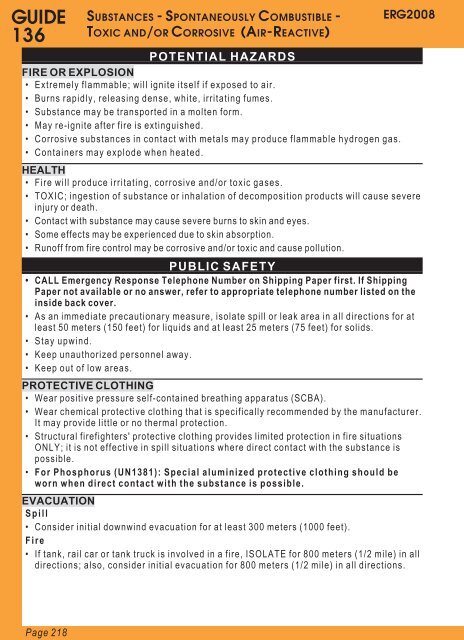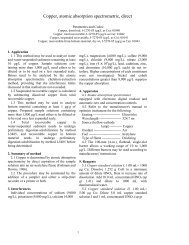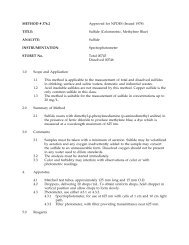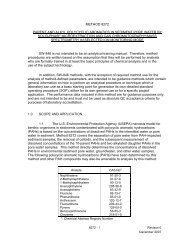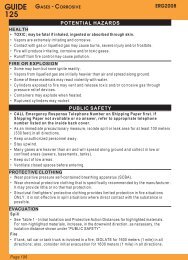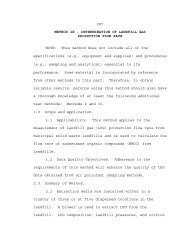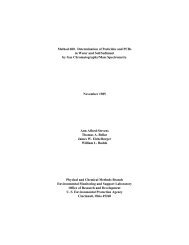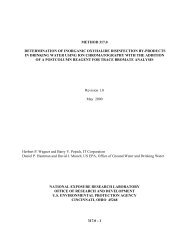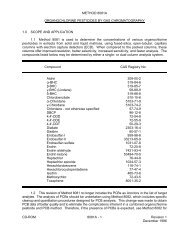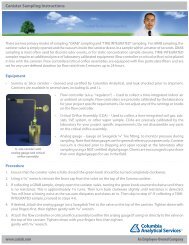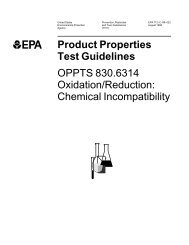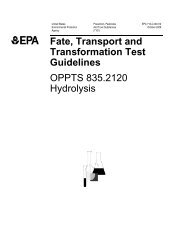Download/Print ERG Guide 136 (PDF)
Download/Print ERG Guide 136 (PDF)
Download/Print ERG Guide 136 (PDF)
You also want an ePaper? Increase the reach of your titles
YUMPU automatically turns print PDFs into web optimized ePapers that Google loves.
Page 218GUIDE<strong>136</strong>SUBSTANCES - SPONTANEOUSLY C OMBUSTIBLE -TOXIC AND/OR C ORROSIVE (AIR-REACTIVE)POTENTIAL HAZARDSFIRE OR EXPLOSION• Extremely flammable; will ignite itself if exposed to air.• Burns rapidly, releasing dense, white, irritating fumes.• Substance may be transported in a molten form.• May re-ignite after fire is extinguished.• Corrosive substances in contact with metals may produce flammable hydrogen gas.• Containers may explode when heated.<strong>ERG</strong>2008HEALTH• Fire will produce irritating, corrosive and/or toxic gases.• TOXIC; ingestion of substance or inhalation of decomposition products will cause severeinjury or death.• Contact with substance may cause severe burns to skin and eyes.• Some effects may be experienced due to skin absorption.• Runoff from fire control may be corrosive and/or toxic and cause pollution.PUBLIC SAFETY• CALL Emergency Response Telephone Number on Shipping Paper first. If ShippingPaper not available or no answer, refer to appropriate telephone number listed on theinside back cover.• As an immediate precautionary measure, isolate spill or leak area in all directions for atleast 50 meters (150 feet) for liquids and at least 25 meters (75 feet) for solids.• Stay upwind.• Keep unauthorized personnel away.• Keep out of low areas.PROTECTIVE CLOTHING• Wear positive pressure self-contained breathing apparatus (SCBA).• Wear chemical protective clothing that is specifically recommended by the manufacturer.It may provide little or no thermal protection.• Structural firefighters' protective clothing provides limited protection in fire situationsONLY; it is not effective in spill situations where direct contact with the substance ispossible.• For Phosphorus (UN1381): Special aluminized protective clothing should beworn when direct contact with the substance is possible.EVACUATIONSpill• Consider initial downwind evacuation for at least 300 meters (1000 feet).Fire• If tank, rail car or tank truck is involved in a fire, ISOLATE for 800 meters (1/2 mile) in alldirections; also, consider initial evacuation for 800 meters (1/2 mile) in all directions.
Page 219<strong>ERG</strong>2008GUIDETOXIC AND/OR C ORROSIVE (A IR-REACTIVE)<strong>136</strong>SUBSTANCES - SPONTANEOUSLY COMBUSTIBLE -EM<strong>ERG</strong>ENCY RESPONSEFIRESmall Fire• Water spray, wet sand or wet earth.Large Fire• Water spray or fog.• Do not scatter spilled material with high pressure water streams.• Move containers from fire area if you can do it without risk.Fire involving Tanks or Car/Trailer Loads• Fight fire from maximum distance or use unmanned hose holders or monitor nozzles.• Cool containers with flooding quantities of water until well after fire is out.• Withdraw immediately in case of rising sound from venting safety devices ordiscoloration of tank.• ALWAYS stay away from tanks engulfed in fire.SPILL OR LEAK• Fully encapsulating, vapor protective clothing should be worn for spills andleaks with no fire.• ELIMINATE all ignition sources (no smoking, flares, sparks or flames in immediate area).• Do not touch or walk through spilled material.• Do not touch damaged containers or spilled material unless wearing appropriateprotective clothing.• Stop leak if you can do it without risk.Small Spill• Cover with water, sand or earth. Shovel into metal container and keep material under water.Large Spill• Dike for later disposal and cover with wet sand or earth.• Prevent entry into waterways, sewers, basements or confined areas.FIRST AID• Move victim to fresh air. • Call 911 or emergency medical service.• Give artificial respiration if victim is not breathing.• Administer oxygen if breathing is difficult.• In case of contact with substance, keep exposed skin areas immersed in water or coveredwith wet bandages until medical attention is received.• Removal of solidified molten material from skin requires medical assistance.• Remove and isolate contaminated clothing and shoes at the site and place in metalcontainer filled with water. Fire hazard if allowed to dry.• Effects of exposure (inhalation, ingestion or skin contact) to substance may be delayed.• Keep victim warm and quiet.• Ensure that medical personnel are aware of the material(s) involved and takeprecautions to protect themselves.


